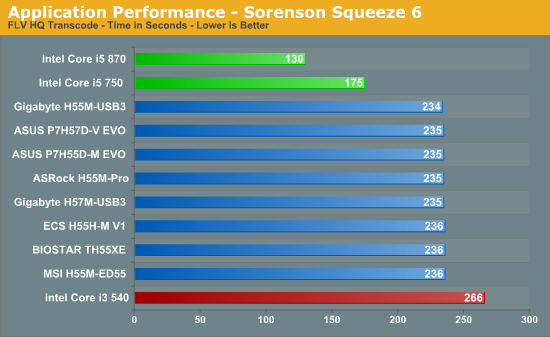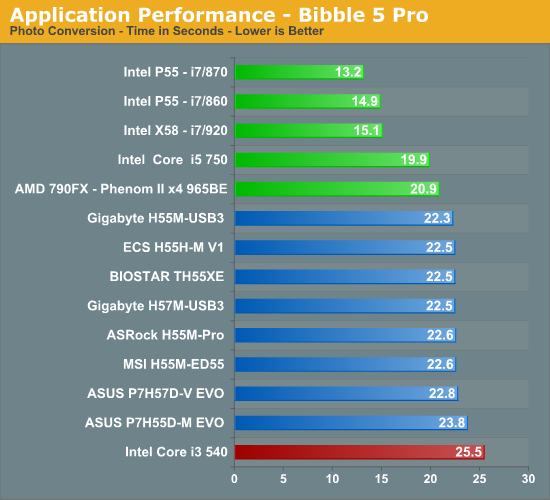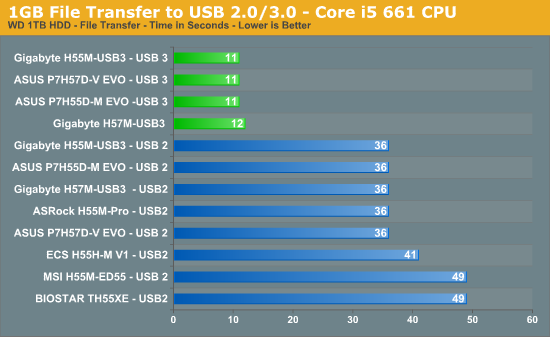Choosing the Best H55/H57 Motherboard, Part 2
by Rajinder Gill on February 22, 2010 2:00 AM EST- Posted in
- Motherboards
Sorenson Squeeze 6
We are using Sorenson Squeeze to convert eight AVCHD videos into HD Flash videos for use on websites. This application heavily favors physical core count and processor clock speed.

WinRAR 3.9 x64
This benchmark compresses our AT workload consisting of a main folder that contains 954MB of files in 15 subfolders. The result is a file approximately 829MB in size.

Bibble 5.0
We utilize Bibble Labs' Bibble 5 v2 to convert 50 RAW image files into full size JPEG images with the program's default settings. This program is fully multithreaded and multi-core aware.

File Transfer to USB
In this test we use Sharkoon's USB 3.0 QuickPort with a 1TB Western Digital hard drive and transfer a 1GB and file from a 1TB HDD connected to the Intel PCH.

We've got a couple of stragglers in this test on the USB 2.0 interface; it seems BIOSTAR and MSI have some work to do on the USB side of operation. The general consensus is that USB 3.0 transfer times are around 10 seconds per gigabyte, while USB 2 delivers an average time of 36~40 seconds per GB. We did try some larger transfers and the scaling is fairly close to linear; a 6GB file transfer takes around 3mins 50 seconds on USB 2.0, while USB 3.0 manages the same file in 1 minute 16 seconds. Although the gains provided by the USB 3.0 interface are obvious, external drives only benefit if you use them for reading/writing large files or making complete drive images; random reads/writes are bottlenecked by the HDD seek times and USB latency.










56 Comments
View All Comments
7Enigma - Monday, February 22, 2010 - link
Taft,Why does the MSRP really matter? Unless you are looking to buy in bulk, I don't really see what the benefit would be. For instance the Intel 80gig SSD has been inflated for months now. It's still a great product, and I don't know why someone wouldn't buy something if the price was higher than MSRP. Many electronic products sell below MSRP, and IMO that does't make them any better or worse.
More importantly than MSRP in my opinion is shopping around to get the best price at any given point. 15-30min of googling around to various E-tailers will give you a good ballpark of the price.
Rajinder Gill - Monday, February 22, 2010 - link
Hi,Unfortunately, I haven't seen or heard of any such resource from any of the sub-vendors - I usually have to fire off emails to ask. I agree with you though, it would be nice to see the figures posted on vendor websites.
regards
Raja
willsonjone - Tuesday, March 22, 2011 - link
Samsung, a respected brand keeps introducing mobile phones that match today’s speed and technology. Samsung has gone great lengths this time as it has received impressive reviews for its new Galaxy S 4G which happens to be the first 4G Phone with 21+ Mbps speeds.Samsung Galaxy S 4G
Kid98 - Monday, February 22, 2010 - link
(ASUS is using a 188 amp capable VRM vs a guessed 110~120amp VRM on the Gigabyte H55/H57 boards, so we'd pick the ASUS boards for Lynnfield CPU overclocking)Looks like the units used to express the capabilities of the VRM's is incorrect, otherwise I am going to need a really large PSU to run them....
Kid
Swivelguy2 - Monday, February 22, 2010 - link
That's 100+ amps delivered at a Vcore of ~1 volt, not 100+ amps drawn from the 12v rail.Earballs - Monday, February 22, 2010 - link
I don't understand these Farcry 2 benchmark results.How is this score against the i5 750 being calculated? Did you test all these boards with that processor then average it? :S
If the first result is the 661@stock and the second the 661@4Ghz, why is the comparison to the i5 750 number not the same in both charts? What changed for the 750? The graphics settings appear to be the same.
Rajinder Gill - Monday, February 22, 2010 - link
The 750 was benched on the EVGA P55 FTW board. Same drives, same drivers, same GPU, same patch version of FC2. Not sure why Lynn (4core) does worse in this bench.later
Raja
Earballs - Monday, February 22, 2010 - link
Okay thanks, but that doesn't explain this:If the first result is the 661@stock and the second the 661@4Ghz, why is the comparison to the i5 750 number not the same in both charts? What changed for the 750? The graphics settings appear to be the same.
Rajinder Gill - Monday, February 22, 2010 - link
Hi,The 750 was OC'd to 4GHz in the second chart, which is why the figure is 5FPS higher than the stock number of 68fps.
I can update the graph in about a day with the 750 running in one of the H55 boards if you like - got the Intel JG on the test rig at present and it won't do 4G's with the 750 I suspect..lol
regards
Raja
Earballs - Monday, February 22, 2010 - link
Ok. It might clear things up to have the 750 labeled as OC'd in the second chart. Thanks for the replies.